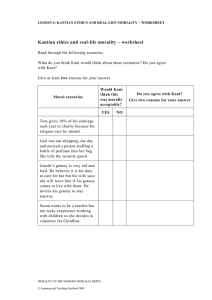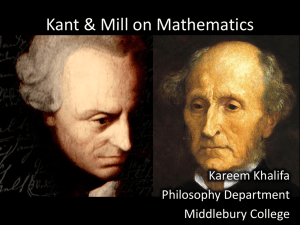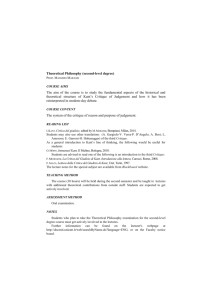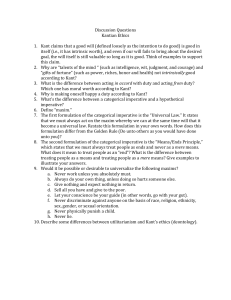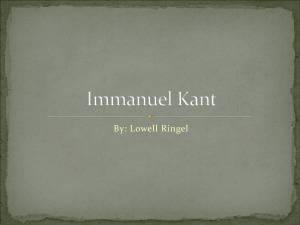1 Kant has a Distinction between phenomena and things in themselves: ... argued, is not idealism. Kant says that we have...
advertisement
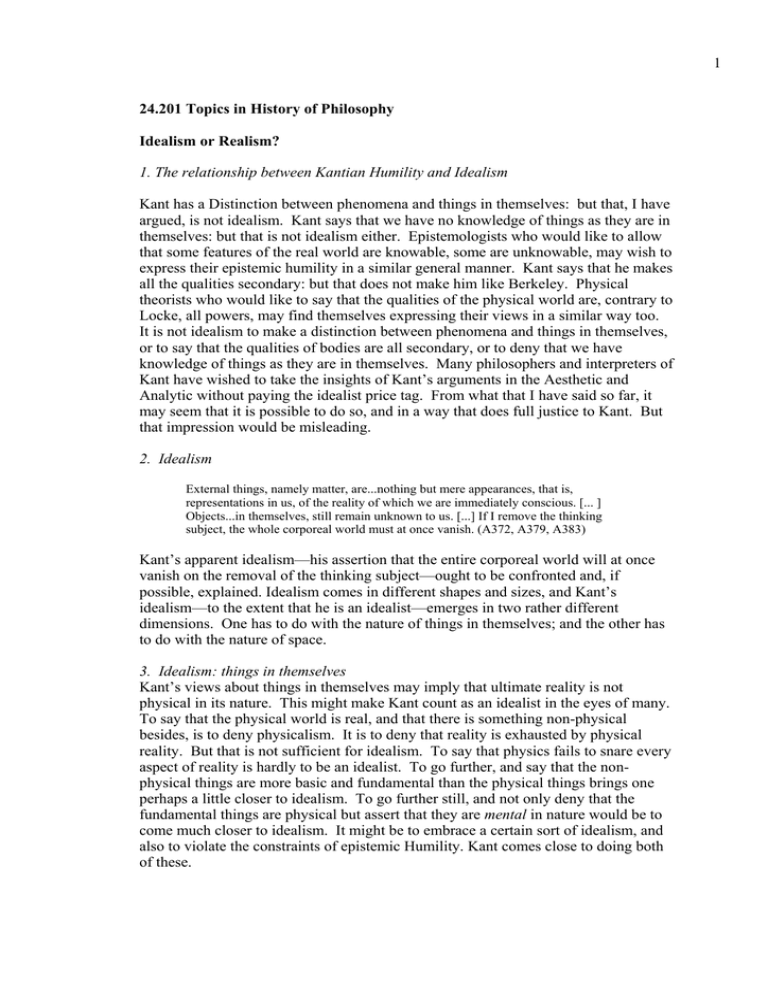
1 24.201 Topics in History of Philosophy Idealism or Realism? 1. The relationship between Kantian Humility and Idealism Kant has a Distinction between phenomena and things in themselves: but that, I have argued, is not idealism. Kant says that we have no knowledge of things as they are in themselves: but that is not idealism either. Epistemologists who would like to allow that some features of the real world are knowable, some are unknowable, may wish to express their epistemic humility in a similar general manner. Kant says that he makes all the qualities secondary: but that does not make him like Berkeley. Physical theorists who would like to say that the qualities of the physical world are, contrary to Locke, all powers, may find themselves expressing their views in a similar way too. It is not idealism to make a distinction between phenomena and things in themselves, or to say that the qualities of bodies are all secondary, or to deny that we have knowledge of things as they are in themselves. Many philosophers and interpreters of Kant have wished to take the insights of Kant’s arguments in the Aesthetic and Analytic without paying the idealist price tag. From what that I have said so far, it may seem that it is possible to do so, and in a way that does full justice to Kant. But that impression would be misleading. 2. Idealism External things, namely matter, are...nothing but mere appearances, that is, representations in us, of the reality of which we are immediately conscious. [... ] Objects...in themselves, still remain unknown to us. [...] If I remove the thinking subject, the whole corporeal world must at once vanish. (A372, A379, A383) Kant’s apparent idealism—his assertion that the entire corporeal world will at once vanish on the removal of the thinking subject—ought to be confronted and, if possible, explained. Idealism comes in different shapes and sizes, and Kant’s idealism—to the extent that he is an idealist—emerges in two rather different dimensions. One has to do with the nature of things in themselves; and the other has to do with the nature of space. 3. Idealism: things in themselves Kant’s views about things in themselves may imply that ultimate reality is not physical in its nature. This might make Kant count as an idealist in the eyes of many. To say that the physical world is real, and that there is something non-physical besides, is to deny physicalism. It is to deny that reality is exhausted by physical reality. But that is not sufficient for idealism. To say that physics fails to snare every aspect of reality is hardly to be an idealist. To go further, and say that the nonphysical things are more basic and fundamental than the physical things brings one perhaps a little closer to idealism. To go further still, and not only deny that the fundamental things are physical but assert that they are mental in nature would be to come much closer to idealism. It might be to embrace a certain sort of idealism, and also to violate the constraints of epistemic Humility. Kant comes close to doing both of these. 2 In the Second Paralogism of the Critique Kant attempts to refute rational psychology’s claim that what is distinctive about the soul is that it is simple. Kant’s reply to this claim is that simplicity may well not be distinctive of souls, since things in themselves, as the substratum of matter, may, for all we know, equally be simple. However, Kant now goes further, and speculates that things in themselves are Leibnizian souls. He speculates that their intrinsic properties—about which so little has been and can be said—are the sorts of properties possessed by souls or thinking beings. Extension, impenetrability, cohesion, and motion—in short, everything which outer senses can give us—are not thought, feeling, desire, or resolution, nor contain them, since these are never objects of external intuition. It could nevertheless be that the something which lies at the ground of external appearances, which affects our sense so that our sense receives representations of space, matter, shape, and so on—it could be that this something, when regarded as noumenon (or better, as transcendental object), is at the same time the subject of thoughts. (A358) Kant suggests here that the substratum of matter is a thinking being. Kant suggests that the intrinsic properties of substances are thoughts—that things as they are in themselves are thinkers. This does come very close to an idealism—but an idealism that is not a phenomenalism. It opens the way for an entirely different understanding of Kant’s startling declaration that, “If I remove the thinking subject, the whole corporeal world must at once vanish” (A383). If the substratum of matter is a thinking monad, then Kant’s declaration would be perfectly accurate. And it would be accurate for a reason very different to the reason it would be accurate when applied to a phenomenalistic idealism. The reason would not be the following familiar reason. “To be is to be perceived; if I remove the thinking, perceiving subject, I remove both perceiver and perceived. Therefore if I remove the thinking, perceiving subject the whole corporeal world must at once vanish.” Instead, the reason would be something like this. “To be a substance is to be a being that has thoughts; if I remove the thinking being, I remove the substance and all of its properties; if the substance has physical properties as well as thoughts, then if remove the substance I remove its physical properties too. Therefore if I remove the thinking subject, the whole corporeal world must at once vanish.” If the substratum of matter is a thinking being, then the vanishing of the substratum would be the vanishing of matter and the whole corporeal world—even if the properties consituting matter are not mental at all. Physical properties may be real, not mental, not things for which to be is to be perceived; and yet it may be true that if the thinking subjects were removed, the physical world would also be removed. 4. Idealism: space It’s time to confront the fact that Kant believes that space is ideal. Kant says repeatedly throughout the Critique that space is a merely subjective form of intuition. The goal of the Aesthetic is to establish the ideality of space. This dimension to Kant’s idealism can hardly be dismissed as an unwise and atypical aberration. Three questions, though: (1) Is Kant’s idealism about space the explanation for his conclusion that we have no knowledge of things in themselves? If the answer to this question is no, we must look 3 elsewhere for an explanation, and the explanation I have offered may well be the right one. (2) Is idealism about space detachable from Kant’s philosophy? If the answer to this question is yes, then a realist understanding of phenomena of the kind suggested here may well be compatible with what Kant ought to have said about space. (3) Is idealism about space compatible, in Kant’s view, with realism about bodies in space? If the answer to this question is yes, then a realist understanding of phenomena may well be compatible with what the philosopher actually said about space. Let us consider these one at a time. In response to (1), our ignorance of things in themselves is supposed to follow from Receptivity, and not from any particular Kantian doctrine about space. In response to (2) some commentators have argued that idealism about space is detachable from the rest of Kant’s philosophy. According to Paul Guyer, Kant infers from the a priori character of our knowledge of space to the subjectivity and ideality of space, but his argument rests on a modal error. It rests on a conflation of the following propositions: (a) Necessarily, if we are to perceive an object, then it is spatial; and (b) If we perceive an object, then it is necessarily spatial. The first, according to Guyer, is sufficient for the claim about our a priori knowledge of space. The second, he says, implies the subjectivity of space. But to move from the first proposition to the second is to commit a modal scope fallacy. So the idealist conclusion about space is indeed detachable from Kant’s arguments about our a priori knowledge of space.1 Guyer’s strategy, or something like it, might show that Kant’s idealism about space is based on a philosophical mistake. It would then be quite possible to disentangle the Kantian idealism which has its source in the supposed subjectivity of space from the other parts of Kant’s philosophy, just as Guyer recommends. And on such an understanding, there would be no temptation whatsoever to regard phenomena as ideal. Phenomena would be wholly real. However, Kant would still make the Distinction between phenomena and things in themselves: he would distinguish the relational properties of substances from the substances in themselves, the substances as bearers of intrinsic properties. He would still insist on Humility: he would insist on our inevitable ignorance of the intrinsic properties of things, for this, as he says, follows from Receptivity. And human knowledge is inevitably receptive, whether or not space is ideal. In response to (3). it may be that Kant’s idealism about space is compatible, even in Kant’s own view, with realism about bodies in space. Phenomena may be real, even if space is ideal. True, Kant sometimes says matter is “only a species of representations...which are called external...because they relate perceptions to the space in which all things are external to one another, while yet the space itself is in us” (A370). Such representations have this “deceptive property that, representing objects in space, they detach themselves as it were from the soul and appear to hover outside it” (A385). But elsewhere we find a different train of thought, as Guyer has shown. Kant says in a letter to Beck of 1792: 1Guyer, Kant and the Claims, p. 364. 4 Messrs. Eberhard and Garve’s opinion that Berkeley’s idealism is the same as that of the critical philosophy (which I could better call “the principle of the ideality of space and time”) does not deserve the slightest attention. For I speak of ideality in reference to the form of representations; but they interpret this to mean ideality with respect to the matter, that is, the ideality of the object. Kant wants to contrast his own philosophy with the phenomenalism of Berkeley by saying that the Kantian philosophy makes merely “the form” ideal, and not the objects presented in spatial form There are good reasons for thinking that in Kant’s own opinion, idealism about space is compatible with realism about phenemenal objects. If this is so, then a realist understanding of phenomena might be compatible not only with what the Kant ought to have said about space, but with what he actually said about space. Bodies would be things, even if they were not present [to us]. But space is always only form. (R5320) The “matter” for which space provides the form is not ideal, but neither, I suggest, is it the thing as it is in itself. Rather, the matter for which space provides the form is force, a relational property of the thing in itself. Force is a relational property, to which space, itself a system of relations, is in some way appropriate. Kant says in the Prolegomena that space is “appropriate” (gemäß) to the “relations” that link our receptive sensibility with objects (Lucas trans. P. 46). Such relations are the forces or causal powers of objects. So space, a system of formal and ideal relations, is in some way appropriate to the real relations of force. Spatial relations provide us with a kind of grid, or map, or blueprint, that enables us to represent material things as objects that are distinct from us, and distinct from each other. By means of external sense...we represent to ourselves objects as distinct from us, and all without exception in space. (A22/B37) The ideality of space does not seem, in Kant’s own opinion, to undermine the reality of what is presented in space: namely bodies, constituted by forces that are mindindependent properties of absolutely independent substances, things in themselves. [The content of this handout overlaps significantly with Chapter 10 of Langton, Kantian Humility.]
